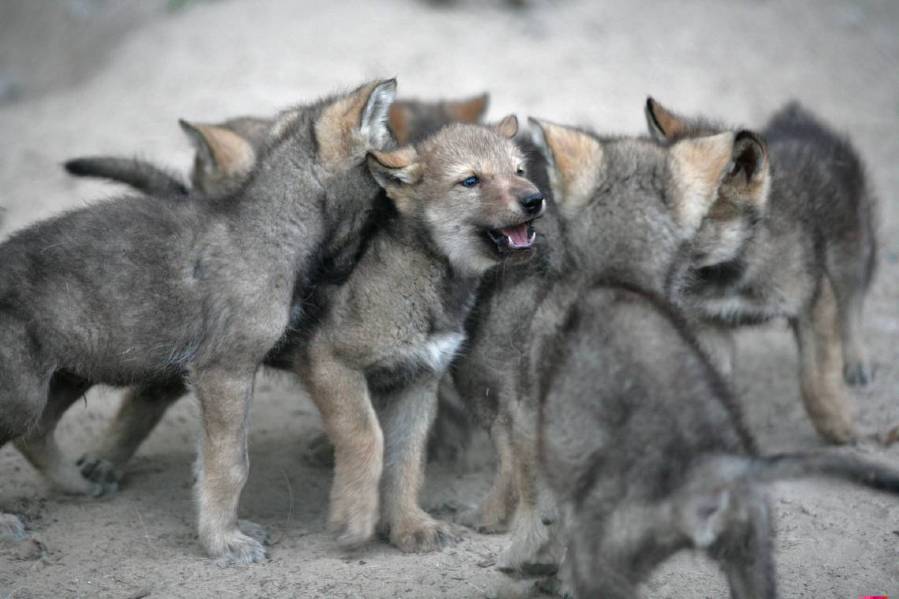You know your dog gets your gist when you point and say “go find the ball” and he scampers right to it.
This knack for understanding human gestures may seem unremarkable, but it’s a complex cognitive ability that is rare in the animal kingdom. Our closest relatives, the chimpanzees, can’t do it. And the dogs’ closest relative, the wolf, can’t either, according to a new Duke University-led study published July 12 in the journal Current Biology.
More than 14,000 years of hanging out with us has done a curious thing to the minds of dogs. They have what are known as “theory of mind” abilities, or mental skills allowing them to infer what humans are thinking and feeling in some situations.
The study, a comparison of 44 dog and 37 wolf puppies who were between 5 and 18 weeks old, supports the idea that domestication changed not just how dogs look, but their minds as well.

At the Wildlife Science Center in Minnesota, wolf puppies were first genetically tested to make sure they were not wolf – dog hybrids. The wolf puppies were then raised with plenty of human interaction. They were fed by hand, slept in their caretakers’ beds each night, and received nearly round-the-clock human care from just days after birth. In contrast, the dog puppies from Canine Companions for Independence lived with their mother and littermates and had less human contact.
Then the canines were tested. In one test, the researchers hid a treat in one of two bowls, then gave each dog or wolf puppy a clue to help them find the food. In some trials, the researchers pointed and gazed in the direction the food was hidden. In others, they placed a small wooden block beside the right spot — a gesture the puppies had never seen before — to show them where the treat was hidden.
The results were striking. Even with no specific training, dog puppies as young as eight weeks old understood where to go, and were twice as likely to get it right as wolf puppies the same age who had spent far more time around people.
Seventeen out of 31 dog puppies consistently went to the right bowl. In contrast, none out of 26 human-reared wolf pups did better than a random guess. Control trials showed the puppies weren’t simply sniffing out the food.
Even more impressive, many of the dog puppies got it right on their first trial. Absolutely no training necessary. They just get it.
It’s not about which species is “smarter,” said first author Hannah Salomons, a doctoral student in Brian Hare’s lab at Duke. Dog puppies and wolf puppies proved equally adept in tests of other cognitive abilities, such as memory, or motor impulse control, which involved making a detour around transparent obstacles to get food.
It was only when it came to the puppies’ people-reading skills that the differences became clear.
“There’s lots of different ways to be smart,” Salomons said. “Animals evolve cognition in a way that will help them succeed in whatever environment they’re living in.”
Other tests showed that dog puppies were also 30 times more likely than wolf pups to approach a stranger.
“With the dog puppies we worked with, if you walk into their enclosure they gather around and want to climb on you and lick your face, whereas most of the wolf puppies run to the corner and hide,” Salomons said.
And when presented with food inside a container that was sealed so they could no longer retrieve it, the wolf pups generally tried to solve the problem on their own, whereas the dog puppies spent more time turning to people for help, looking them in the eye as if to say: “I’m stuck can you fix this?”
Senior author Brian Hare says the research offers some of the strongest evidence yet of what’s become known as the “domestication hypothesis.”
Somewhere between 12,000 and 40,000 years ago, long before dogs learned to fetch, they shared an ancestor with wolves. How such feared and loathed predators transformed into man’s best friend is still a bit of a mystery. But one theory is that, when humans and wolves first met, only the friendliest wolves would have been tolerated and gotten close enough to scavenge on the human’s leftovers instead of running away. Whereas the shyer, surlier wolves might go hungry, the friendlier ones would survive and pass on the genes that made them less fearful or aggressive toward humans.
The theory is that this continued generation after generation, until the wolf’s descendants became masters at gauging the intentions of people they interact with by deciphering their gestures and social cues.
“This study really solidifies the evidence that the social genius of dogs is a product of domestication,” said Hare, professor of evolutionary anthropology at Duke.
It’s this ability that makes dogs such great service animals, Hare said. “It is something they are really born prepared to do.”
Much like human infants, dog puppies intuitively understand that when a person points, they’re trying to tell them something, whereas wolf puppies don’t.
“We think it indicates a really important element of social cognition, which is that others are trying to help you,” Hare said.
“Dogs are born with this innate ability to understand that we’re communicating with them and we’re trying to cooperate with them,” Salomons said.
This research was supported by the Office of Naval Research (N00014- 16-12682), the Eunice Kennedy Shriver National Institute of Child Health and Human Development of the National Institutes of Health (NIH-1Ro1HD097732) and the AKC Canine Health Foundation (#2700).
CITATION: “Cooperative Communication with Humans Evolved to Emerge Early in Domestic Dogs,” Hannah Salomons, Kyle Smith, Megan Callahan-Beckel, Margaret Callahan, Kerinne Levy, Brenda S. Kennedy, Emily Bray, Gitanjali E. Gnanadesikan, Daniel J. Horschler, Margaret Gruen, Jingzhi Tan, Philip White, Evan MacLean, Brian Hare. Current Biology, July 12, 2021. DOI: 10.1016/j.cub.2021.06.051


